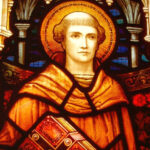St Enda of Arran, also known as Eanna, Enda of Arranmore, Endeus or Enna, is an Irish Saint of the Roman Catholic Church. Historical Researchers are unsure of his birth date, it is widely believed that he was born in Meath, Ireland. He died around 530 of natural causes. His feast day is on the 21st of March.
The Early life of Enda
Research states that in his early life, Enda was an Irish Prince; he was the son of Conall Derg of Oriel, in Ulster.
Legend has it he went on in life to become a warrior and King of Oriel.
The story has it that Enda visited his sister, Saint Fanchea, who was an abbess. She tried to persuade Enda to lay down his arms and be at peace. He agreed, however, only if she would give him a young girl in the convent for a wife. The girl Fanchea promised turned out to have suddenly died, and Enda only saw his fiancée as a corpse.
Enda was deeply disturbed by this loss, and lost all interest in his life, and gave up his claim to the throne. He then took a different path in life and devoted himself to Christianity.
After this turn of events, Enda made a pilgrimage to Rome, where he was ordained. Later, he returned to Ireland where he founded and built churches in Drogheda.
It is said then around the year of 484, Enda begged his brother-in-law, who was King Oengus of Munster, to let him go into the wild island of Innish in Galway Bay. However Oengus felt this wasn't good enough and wanted to give him a fertile plot in Golden Vale, but Enda felt that the wilderness of Innish was more suited to his religious life.
Innish Monastery
On Innish he founded the monastery of Enda, it has been claimed that this was the first-ever Irish monastery. The monks who lived in this monastery lived a hard life of work, prayer, fasting and studying Scriptures.
The story goes that no fire was ever allowed to be lit to give heat in the cold stone cells. This was a sign of total dedication and sacrifice to God.
The men who dedicated their lives here were known as, "the men of the caves" or the "men of the cross". They were said to remember how the lord was born in a manger and had nowhere to lay his head, from this they lived their lives the same deprived way.
Over the years the island's population grew with the Monastery. Enda had his own means and ways of developing the island. He developed it into eight parts, and in each part, he built a place of refuge. Whilst under his power his abbey flourished and it became a sacred place for centuries.
Life on the Island To-day
It is ironic, for today cattle, goats, and horses now huddle and shiver in the storms under many of the ruins of old walls where once men lived and prayed, and where many went to seek refuge.
Most of the surviving constructions are the coastal ruined towers.
Today, Arran is a popular location for tourists. With mini-buses catering to take people on scenic tours, there is plenty to see on the island.
Pubs on the island attract many visitors with their Traditional Irish Music, along with rock and jazz.
Although the island itself is famous for its Aran Jumpers, there are no sheep on Inis Mor. There are few skilled hand-knitters left on the island and the majority of Aran sweaters are made of imported wool and produced elsewhere.










